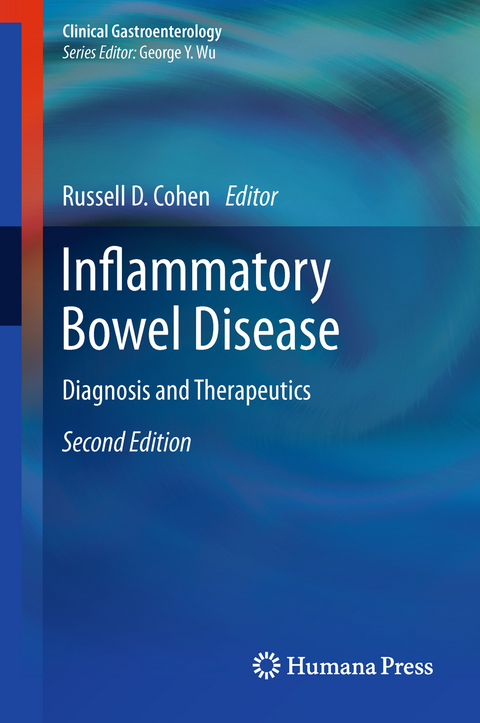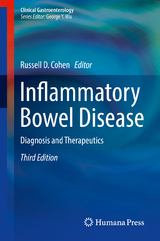
Inflammatory Bowel Disease
Humana Press Inc. (Verlag)
978-1-61779-731-6 (ISBN)
- Lieferbar
- Versandkostenfrei
- Auch auf Rechnung
- Artikel merken
As in the first edition of Inflammatory Bowel Diseases this new edition continues to provide readers with a concise, yet in-depth review of many of the important areas in the history, epidemiology, pathogenesis, diagnosis, and treatment of the inflammatory bowel diseases (ulcerative colitis and Crohn's disease), as well as associated issues: extraintestinal manifestations, ostomy care, women's issues, economics, etc. This Second Edition provides the reders with up-to-date, state-of-the art approaches to these disease states, with expansion into the newer topics that have emerged in the past few years which include the expansion of biological agents for treatment, new studies in the epidemiology of IBD, the changing economics of IBD, breakthroughs in new endoscopic evaluations, major advances in novel radiographic techniques, the detection of colorectal cancer in patients with IBD and new findings in the genetics of IBD.
New Trend / Developments (* These all emerged since our last edition)
The most critical trend that has arisen over the past few years has been the introduction and expansion of biological agents in the treatment of inflammatory diseases worldwide. While only one agent, infliximab (Remicade), existed at the time of publication of my first edition, there have been multiple other agents either approved or pending approval for the treatments of these diseases, or in the upper-stages of development. The impact is not only upon the patients, but also on the health-care providers, policy makers, researchers, biotech and pharmacompanies, and the business community.
Major changes worldwide in the epidemiology of IBD has spurred new studies in the demographics of who is getting these diseases and why. Previously characterized as diseases primarily affected Caucasians in industrialized countries, there has been an explosion of growth amongst the African American and Hispanic populations in the United States, and well as in pockets of these and other ethnic groups worldwide.
The economics of IBD has been changing greatly, given the issues raised above, as well as major changes in the United States Medicare program, and other insurance changes. The growing proportion of the GNP that healthcare costs are consuming in the US and worldwide has shifted attention to decreasing utilization of health care services, and other cost-savings measures. Again, up to this point this has been an exclusive part of our IBD book.
New findings in the genetics of IBD have been recently published. Our first edition had the finding of the first Crohn’s disease gene inserted just before going to press; so much has been published about the phenotypes and other genotypes that have emerged.
Breakthroughs in new endoscopic evaluations of the bowel (ie. Capsule endoscopy, double-balloon enteroscopy, endoscopic ultrasound) and their use in the inflammatory bowel diseases will be a key highlight of this new book.
Major advances in novel radiographic techniques employed in patients with inflammatory bowel disease (ie. CT enterography, MR enterography, advanced ultrasounds, etc.) will also an important component of our work.
There have been numerous areas related to the development and detection of colorectal cancer in patients with IBD that have emerged in the past few years. Techniques of better detection (ie. Narrow band imaging; special mucosal staining; endoscopic histological evaluations) as well as research in the putative role of mesalamine and other agents for colorectal cancer prevention are all hot topics that will attract much interest from a variety of interest groups I described above.
Identification of additional disease states that probably belong in the IBD family, such as microscopic colitis (including lymphocytic colitis), and collagenous colitis add to the diseases that will be discussed in this new edition.
The Influence of 20th-Century Biomedical Thought on the Origins of Inflammatory Bowel Disease Therapy.- The Changing Epidemiology of IBD.- Recent Advances in the Genetics of IBD.- New Paradigms in the Pathogenesis of IBD.- State of the Art Medical Treatment of the Adult Patient with IBD: The Mesalamine-based Therapies.- State of the Art Medical Treatment of the Adult Patient with IBD: Modern-Use Of Corticosteroids.- State of the Art Medical Treatment of the Adult Patient with IBD: The Immunomodulators.- State of the Art Medical Treatment of the Adult Patient with IBD: The Biological Therapies.- State of the Art Medical Treatment of the Adult Patient with IBD: Prebiotics, Probiotics, Antibiotics, and Nutritional Therapies.- State of the Art Medical Treatment of the Pediatric Patient with IBD.- State of the Art Surgical Treatment of the Patient with IBD.- Clinical Utility of Serological Markers and Thiopurine Drug Monitoring in IBD.- Caring for Women with Inflammatory Bowel Disease.- Novel Radiographic Techniques in IBD Patients.- Novel Techniques in the Diagnosis of Inflammatory Bowel Disease.- Pathology Slide Show: Inflammatory Bowel Disease.- New Findings in the Diagnosis and Prevention of Colorectal Cancer in IBD.- Managing the Patient with a Fecal Diversion.- The New Economic Reality in the World of IBD.
| Reihe/Serie | Clinical Gastroenterology |
|---|---|
| Zusatzinfo | XIV, 322 p. |
| Verlagsort | Totowa, NJ |
| Sprache | englisch |
| Maße | 155 x 235 mm |
| Themenwelt | Medizinische Fachgebiete ► Chirurgie ► Viszeralchirurgie |
| Medizinische Fachgebiete ► Innere Medizin ► Gastroenterologie | |
| Medizinische Fachgebiete ► Radiologie / Bildgebende Verfahren ► Radiologie | |
| Studium ► 2. Studienabschnitt (Klinik) ► Pathologie | |
| ISBN-10 | 1-61779-731-6 / 1617797316 |
| ISBN-13 | 978-1-61779-731-6 / 9781617797316 |
| Zustand | Neuware |
| Informationen gemäß Produktsicherheitsverordnung (GPSR) | |
| Haben Sie eine Frage zum Produkt? |
aus dem Bereich



